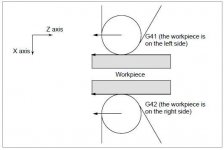Hoppy
Cast Iron
- Joined
- Feb 21, 2005
- Location
- Millington, NJ
There are lots of threads on this topic and the more I read, the more confused I get. Let's say, for example, that I touch a right-hand turning/facing tool to the face of a part to establish its Z offset. Let's also say that this tool has a 0.03 nose radius and this (R) value is entered into the control along with a "2" for the tool type (T) value. Now I command a 0.025" face cut towards the axis and, since the tool is to the right of the work, G42 is turned on. Will this cut be 0.025" deep? If the cut is in the opposite direction (+X) and G41 is turned on, what will its depth be?




